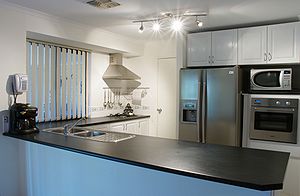According to the National Fire Protection Association, every year, there are more than 300,000 house fires in the U.S., which means a house fire occurs about every minute and a half. House fires kill thousands of people each year, do billions of dollars in damage, and in many cases, are preventable.
This week is National Fire Prevention week and fire departments and public service announcement will be reminding you to check the batteries in your smoke detectors and practice your fire evacuation plan. The best ways for families to stay safe is to take preventative action and practice evacuating. Here at Fill Your Plate, we were surprised to learn that the leading cause of home fires for the past 20 years has been cooking. Since cooking is close to our hearts, we thought the best way to spread awareness about Fire Prevention Week was to focus on how to prevent fires in the kitchen. Here are 5 things you can do to make your kitchen more fire safe.
1. Appliances
When you think about kitchens, fires, and appliances, it is likely your first thought is stoves and ovens. Keeping these clean and free of debris and grease is one of the best ways to decrease the likelihood of having a fire in the kitchen. However, there are other appliances that can also pose a fire danger if not properly taken care of, like the toaster and microwave. Make sure you clean out crumb trays, remove grease and oil buildup, and only use appliances that are in good working order.
2. Accessories
Another fire danger common in the kitchen is clothing, accessories, and hair that can catch fire. Long, flowing sleeves, long, loose necklaces, and long hair can all inadvertently make contact with a heat source and ignite. Avoid these risks by removing them; change your clothes, remove any loose-hanging jewelry, and tie back long hair before cooking.
3. Attention
One of the leading causes of kitchen fires is unattended cooking. It’s easy to do. You are cooking dinner and the doorbell rings, the dryer buzzes, or the neighbor calls. You step away for a few minutes not realizing that it only takes seconds for a fire to start. Turn off the burner or the oven if you need to stay away.
4. Area
Go in your kitchen and look at the stove. How many combustible items like dishtowels, paper towels, and potholders are close enough to catch fire? Keep these items and all other combustible materials away from cooking areas including toasters, toaster oven, mini-grills, and food steamers. If it produces heat, it can cause a fire.
5. Awareness
Make sure that everyone in your house knows where the fire extinguishers are located in the kitchen (and the rest of the house) and how to use them. Educate yourself and family members on the different types of fire and what, if anything, needs to be done differently to extinguish each type. Practice your family’s fire evacuation plan from different rooms in the house, including the kitchen so that everyone knows what to do no matter where they are in the house.
Related articles
- 6 Tips for Organizing Your Kitchen (fillyourplate.org)
- Perfecting Your Pantry: 10 Things to Always Have on Hand (fillyourplate.org)
- How to Spring Clean Your Cupboards (fillyourplate.org)



